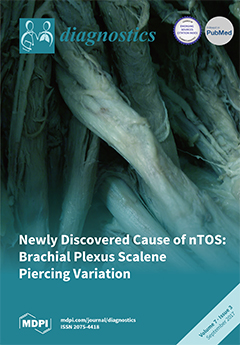Hypoxia is associated with prostate tumor aggressiveness, local recurrence, and biochemical failure. Magnetic resonance imaging (MRI) offers insight into tumor pathophysiology and recent reports have related transverse relaxation rate (R
2*) and longitudinal relaxation rate (R
1) measurements to tumor hypoxia.
[...] Read more.
Hypoxia is associated with prostate tumor aggressiveness, local recurrence, and biochemical failure. Magnetic resonance imaging (MRI) offers insight into tumor pathophysiology and recent reports have related transverse relaxation rate (R
2*) and longitudinal relaxation rate (R
1) measurements to tumor hypoxia. We have investigated the inclusion of oxygen-enhanced MRI for multi-parametric evaluation of tumor malignancy. Multi-parametric MRI sequences at 3 Tesla were evaluated in 10 patients to investigate hypoxia in prostate cancer prior to radical prostatectomy. Blood oxygen level dependent (BOLD), tissue oxygen level dependent (TOLD), dynamic contrast enhanced (DCE), and diffusion weighted imaging MRI were intercorrelated and compared with the Gleason score. The apparent diffusion coefficient (ADC) was significantly lower in tumor than normal prostate. Baseline R
2* (BOLD-contrast) was significantly higher in tumor than normal prostate. Upon the oxygen breathing challenge, R
2* decreased significantly in the tumor tissue, suggesting improved vascular oxygenation, however changes in R
1 were minimal. R
2* of contralateral normal prostate decreased in most cases upon oxygen challenge, although the differences were not significant. Moderate correlation was found between ADC and Gleason score. ADC and R
2* were correlated and trends were found between Gleason score and R
2*, as well as maximum-intensity-projection and area-under-the-curve calculated from DCE. Tumor ADC and R
2* have been associated with tumor hypoxia, and thus the correlations are of particular interest. A multi-parametric approach including oxygen-enhanced MRI is feasible and promises further insights into the pathophysiological information of tumor microenvironment.
Full article






